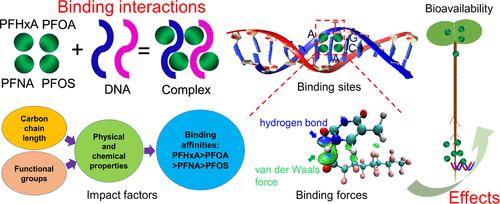当前位置:
X-MOL 学术
›
J. Agric. Food Chem.
›
论文详情
Our official English website, www.x-mol.net, welcomes your
feedback! (Note: you will need to create a separate account there.)
Interactions between Extracellular DNA and Perfluoroalkyl Acids (PFAAs) Decrease the Bioavailability of PFAAs in Pakchoi (Brassica chinensis L.)
Journal of Agricultural and Food Chemistry ( IF 5.7 ) Pub Date : 2022-11-14 , DOI: 10.1021/acs.jafc.2c04597 Chao Qin 1, 2 , Ying-Xin Lu 1 , Thomas Borch 3, 4 , Ling-Ling Yang 1 , Yan-Wen Li 1 , Hai-Ming Zhao 1 , Xiaojie Hu 2 , Yanzheng Gao 2 , Lei Xiang 1 , Ce-Hui Mo 1 , Qing X Li 5
Journal of Agricultural and Food Chemistry ( IF 5.7 ) Pub Date : 2022-11-14 , DOI: 10.1021/acs.jafc.2c04597 Chao Qin 1, 2 , Ying-Xin Lu 1 , Thomas Borch 3, 4 , Ling-Ling Yang 1 , Yan-Wen Li 1 , Hai-Ming Zhao 1 , Xiaojie Hu 2 , Yanzheng Gao 2 , Lei Xiang 1 , Ce-Hui Mo 1 , Qing X Li 5
Affiliation

|
Perfluoroalkyl acids (PFAAs) are emerging ionic organic pollutants worldwide. Great amounts of extracellular DNA (∼mg/kg) coexist with PFAAs in the environment. However, PFAA–DNA interactions and effects of such interactions have not been well studied. Herein, we used isothermal titration calorimetry (ITC), spectroscopy, and computational simulations to investigate the PFAA–DNA interactions. ITC assays showed that specific binding affinities of PFHxA–DNA, PFOA–DNA, PFNA–DNA, and PFOS–DNA were 5.14 × 105, 3.29 × 105, 1.99 × 105, and 2.18 × 104 L/mol, respectively, which were about 1–2 orders of magnitude stronger than those of PFAAs with human serum albumin. Spectral analysis suggested interactions of PFAAs with adenine (A), cytosine (C), guanine (G), and thymine (T), among which grooves associated with thymine were the major binding sites. Molecular dynamics simulations and quantum chemical calculations suggested that hydrogen bonds and van der Waals forces were the main interaction forces. Such a PFAA–DNA binding decreased the bioavailability of PFAAs in plant seedlings. The findings will help to improve the current understanding of the interaction between PFAAs and biomacromolecules, as well as how such interactions affect the bioavailability of PFAAs.
中文翻译:

细胞外 DNA 和全氟烷基酸 (PFAA) 之间的相互作用会降低小白菜 (Brassica chinensis L.) 中 PFAA 的生物利用度
全氟烷基酸 (PFAA) 是全球新兴的离子有机污染物。大量的细胞外 DNA (∼mg/kg) 与环境中的 PFAA 共存。然而,PFAA-DNA 相互作用和这种相互作用的影响尚未得到很好的研究。在此,我们使用等温滴定量热法 (ITC)、光谱学和计算模拟来研究 PFAA-DNA 相互作用。ITC 测定表明,PFHxA–DNA、PFOA–DNA、PFNA–DNA 和 PFOS–DNA 的特异性结合亲和力分别为 5.14 × 10 5、3.29 × 10 5、1.99 × 10 5和 2.18 × 10 4L/mol,分别比含有人血清白蛋白的 PFAAs 强 1-2 个数量级。光谱分析表明 PFAAs 与腺嘌呤 (A)、胞嘧啶 (C)、鸟嘌呤 (G) 和胸腺嘧啶 (T) 相互作用,其中与胸腺嘧啶相关的凹槽是主要的结合位点。分子动力学模拟和量子化学计算表明氢键和范德华力是主要的相互作用力。这种 PFAA-DNA 结合降低了植物幼苗中 PFAA 的生物利用度。这些发现将有助于提高目前对 PFAA 与生物大分子之间相互作用的理解,以及这种相互作用如何影响 PFAA 的生物利用度。
更新日期:2022-11-14
中文翻译:

细胞外 DNA 和全氟烷基酸 (PFAA) 之间的相互作用会降低小白菜 (Brassica chinensis L.) 中 PFAA 的生物利用度
全氟烷基酸 (PFAA) 是全球新兴的离子有机污染物。大量的细胞外 DNA (∼mg/kg) 与环境中的 PFAA 共存。然而,PFAA-DNA 相互作用和这种相互作用的影响尚未得到很好的研究。在此,我们使用等温滴定量热法 (ITC)、光谱学和计算模拟来研究 PFAA-DNA 相互作用。ITC 测定表明,PFHxA–DNA、PFOA–DNA、PFNA–DNA 和 PFOS–DNA 的特异性结合亲和力分别为 5.14 × 10 5、3.29 × 10 5、1.99 × 10 5和 2.18 × 10 4L/mol,分别比含有人血清白蛋白的 PFAAs 强 1-2 个数量级。光谱分析表明 PFAAs 与腺嘌呤 (A)、胞嘧啶 (C)、鸟嘌呤 (G) 和胸腺嘧啶 (T) 相互作用,其中与胸腺嘧啶相关的凹槽是主要的结合位点。分子动力学模拟和量子化学计算表明氢键和范德华力是主要的相互作用力。这种 PFAA-DNA 结合降低了植物幼苗中 PFAA 的生物利用度。这些发现将有助于提高目前对 PFAA 与生物大分子之间相互作用的理解,以及这种相互作用如何影响 PFAA 的生物利用度。











































 京公网安备 11010802027423号
京公网安备 11010802027423号